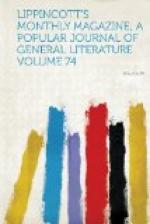When the preceding provisions had been read, Quinones gave to the king-at-arms a letter signed and sealed, which invited to the Pass all knights so disposed, granting safe conduct to those of other kingdoms, and declaring the cause of said trial of arms. Copies of the above letter were also given to other heralds, who were provided with everything necessary for long journeys, and in the six months that intervened before the day fixed for the jousts the matter had been proclaimed throughout all Christendom. Meanwhile, Quinones provided horses and arms and everything necessary for “such an important enterprise.”
In the kingdom of Leon, about ten miles east of Astorga and on the highway from that city to the capital, is the bridge of Orbigo. Suero de Quinones did not select Orbigo with reference to convenience of access from the Castiles, but because it must be passed by pilgrims to Santiago; and that year (1434) was especially sacred to the saint, whose festival, on the 25th of July, has always been celebrated with great pomp. The Spaniards having been forbidden to go to Jerusalem as crusaders, and being too much occupied at home with the Moors to make such a long pilgrimage, wisely substituted Santiago, where the remains of St. James, the patron of Spain, is supposed to rest. His body is said to have floated in a stone coffin from Joppa to Padron (thirteen miles below Santiago) in seven days, and for nearly eight centuries lay forgotten in a cave, but was at length miraculously brought to light by mysterious flames hovering over its resting-place, and in 829 was removed to Santiago. In 846 the saint made his appearance at the celebrated battle of Clavijo, where he slew sixty thousand Moors, and was rewarded by a grant of a bushel of grain from every acre in Spain. His shrine was a favorite resort for pilgrims from all Christendom until after the Reformation, and the saint retained his bushel of grain (the annual value of which had reached the large sum of one million dollars) until 1835.
It was near the highway, in a pleasant grove, that Quinones erected the lists, a hundred and forty-six paces long and surrounded by a palisade of the height of a lance, with various stands for the judges and spectators. At the opposite ends of the lists were entrances—one for the defenders of the Pass—and there were hung the arms and banners of Quinones, as well as at the other entrance, which was reserved for the knights who should come to make trial of their arms. In order that no one might mistake the way, a marble king-at-arms was erected near the bridge, with the right arm extended and the inscription, “To the Pass.”




